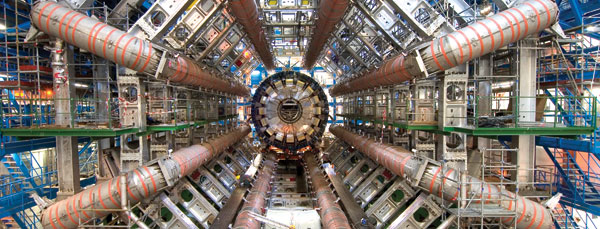Extracts

UF Physicists Active In Large Hadron Collider
Aaron Hoover
When the world's largest particle accelerator went live in early September, University of Florida physicists joined thousands of scientists working to crack the last major mysteries of the physical universe.
A team of UF physicists has a leading role in one of the two major experiments planned for the Large Hadron Collider, a 17-mile-long, $5 billion, super-cooled underground tunnel that has been under construction outside Geneva, Switzerland, for 14 years. It has been described as the largest scientific project in history.
gThe Large Hadron Collider will give us a deeper understanding of whatfs going on with the basic forces of nature,h said Darin Acosta, a UF professor of physics and one of more than two dozen UF faculty or students involved in the experiment.
The accelerator is intended to smash together protons energized with seven trillion electron volts \ recreating in miniature the conditions thought to have existed in the first moments of the gBig Bangh more than 13 billion years ago. Physicists hope at least a few of those collisions will result in new, if extremely rare and fleeting, forms of matter. They believe subsequent analysis could yield clues to the most fundamental mysteries in physics \ mysteries about which there are many theories but few observations.
For example, Acosta said, physicists have explained the presence of mass by theorizing the existence of the Higgs boson, a subatomic particle believed to endow particles with mass. But the Higgs \ sometimes called the gGod particleh because it is the last unobserved particle in the so-called Standard Model of particle physics \ has so far eluded other colliders. Physicists hope the Large Hadron Collider is powerful enough to give them a first glimpse.
Also, there is considerable evidence that the universe contains abundant gdark matterh \ matter that has never been observed but that obeys gravity and other physical forces. Physicists hope some smashed particles will yield the first observation of the mysterious stuff.
gWe could directly see a neutral particle which could be what makes up 90 percent of the universe,h Acosta said.
More than 30 UF physicists, postdoctoral associates and graduate students are involved in the colliderfs Compact Muon Spectrometer, or CMS, experiment, one of its two major experiments. About 10 are stationed in Geneva. The group is the largest from any university in the U.S. to participate in the CMS experiment, said Guenakh Mitselmakher, a UF distinguished professor of physics who heads the project.
The CMS is the colliderfs workhorse: It is designed to capture and measure all phenomena resulting from the proton collisions in the collider, Acosta said.
The UF team designed and oversaw development of a major detector within the CMS. The detector, the Muon system, is intended to capture subatomic particles called muons, which are heavier cousins of electrons. The bulk of the UF research was funded by the U.S. Department of Energy.